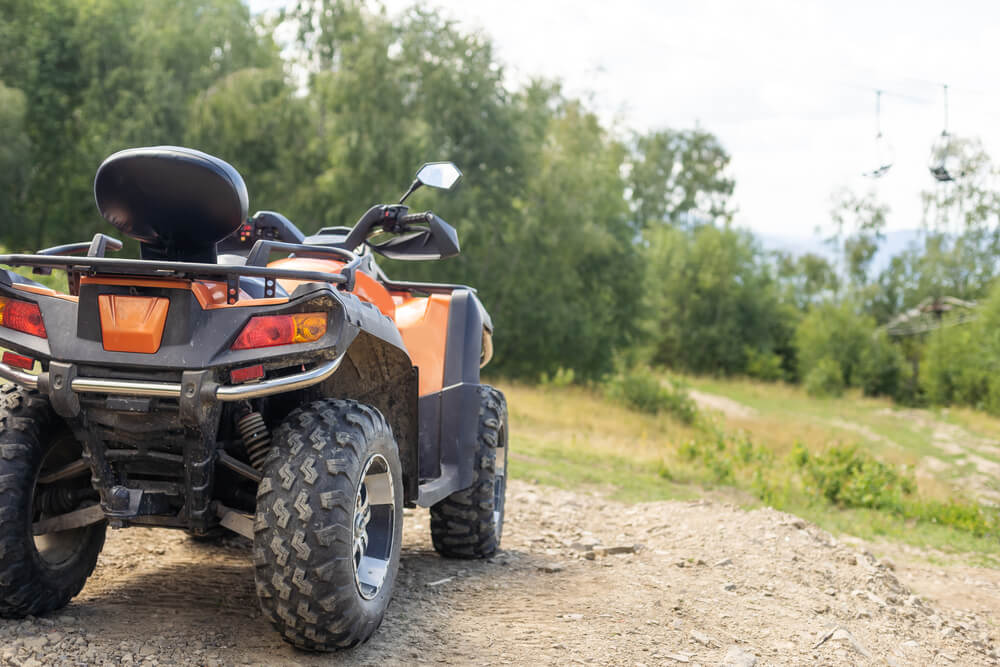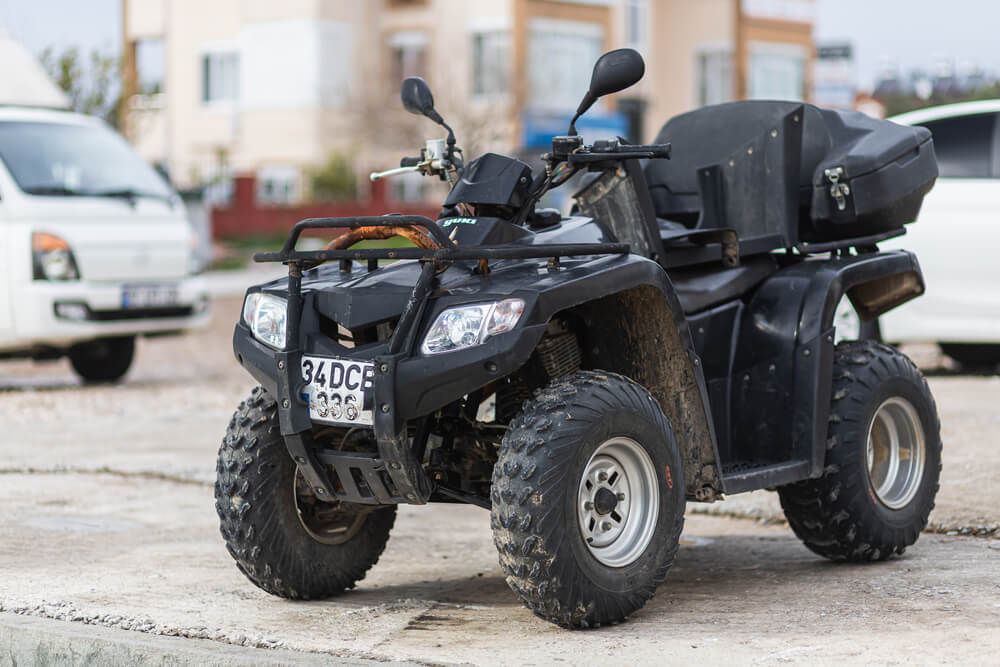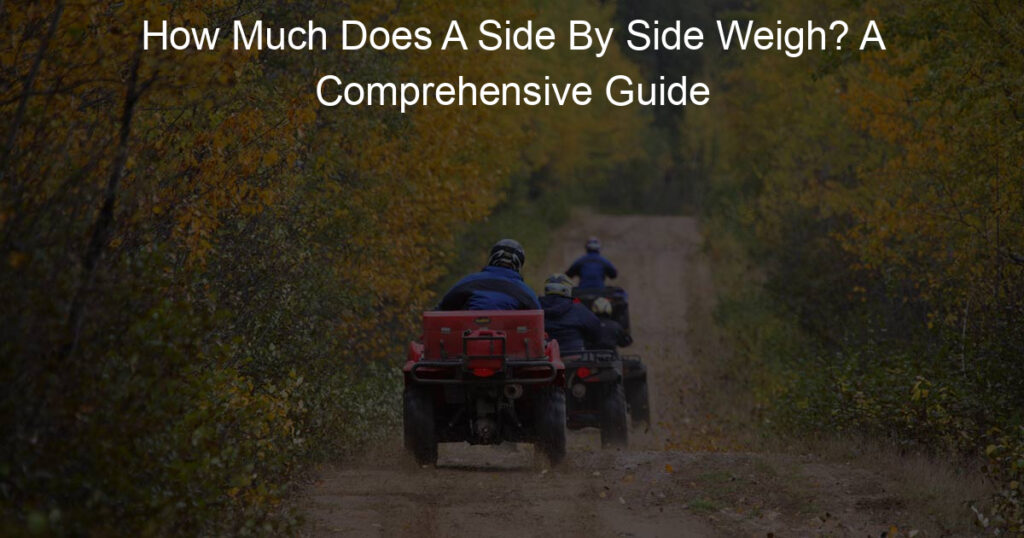When it comes to buying a side-by-side vehicle, one important factor to consider is its weight.
Knowing how much does a Side By Side weigh can help you determine if it’s suitable for your needs, including where you can operate it and how it will affect your vehicle’s towing capacity.
Not only that, but the weight of a side-by-side can also play a significant role in its overall performance and handling on different terrains.
Side-by-side weights can vary greatly depending on factors such as the model, manufacturer, and added accessories. The average weight for most standard equipment UTVs falls between 1,000 to 1,500 pounds.
It’s essential to understand the specific requirements and limitations of your vehicle, including its gross weight, which refers to the combined weight of the side-by-side, its passengers, cargo, and any fluids or fuel.
Key Takeaways
- Weight is an important factor to consider when buying a side-by-side, as it affects performance, handling, and transportation requirements.
- The average side-by-side weighs between 1,000 to 1,500 pounds, with variations due to model, manufacturer, and accessories.
- Understanding the gross weight of your side-by-side ensures proper use within its weight limitations and safe transportation.
How Much Does A Side By Side Weigh?

When considering a side-by-side, it’s essential to understand the various weights associated with these off-road vehicles.
As a potential owner, knowing the weight can help you choose the right towing equipment and understand how much your UTV will affect overall vehicle performance.
Most standard equipment UTVs weigh between 1,000 to 1,500 pounds but keep in mind that the actual weight can vary significantly based on the model, manufacturer, and any added accessories.
Here’s a closer look at some factors that can influence the weight of a side-by-side:
- Passenger capacity: Generally, 2-passenger side-by-side vehicles average around 1,477 pounds, while 4-passenger models average 1,774 pounds. Larger passenger capacities can increase the overall weight.
- Utility vs. sport models: Utility UTVs typically weigh more than sport models, with utility vehicles ranging from 1,200 to 2,000 pounds, while sportier designs can be lighter.
- Youth models: Designed for younger and smaller riders, youth UTVs are considerably lighter than their adult counterparts, usually weighing between 400 and 700 pounds.
- Accessories and modifications: Adding accessories like winches, roof racks, or speaker systems can increase the overall weight of your side-by-side. Keep these additions in mind when considering towing or overall performance.
Understanding the factors that contribute to your side-by-side’s weight, you’ll be better equipped to select the right UTV for your needs while also ensuring you have the proper towing equipment and performance expectations.
Key Components Influencing Weight

In this section, we’ll discuss the key components that influence the weight of a side-by-side vehicle. These vehicles, also known as UTVs, typically weigh between 1,000 to 1,500 pounds.
Yet, the weight can vary significantly based on several factors, such as engine size, materials, and additional components.
Engine Size
The size of the engine in your side-by-side has a significant impact on its overall weight. Generally, larger engines produce more power but also add considerable weight to the vehicle.
It’s essential to strike a balance between engine size and power when considering the weight of a side-by-side, as this will affect its handling, performance, and fuel efficiency.
Materials
The choice of materials used in constructing a side-by-side also plays a crucial role in determining its overall weight. Steel frames are heavier than aluminum ones, contributing around 1000 pounds to a side-by-side’s weight.
This is important to note when comparing vehicles, as a heavier frame might offer greater durability but will also increase fuel consumption and affect handling.
On the other hand, aluminum frames tend to be lighter and more resistant to corrosion. Further, they offer a better power-to-weight ratio, providing better performance and potentially reduced fuel consumption.
Components
Lastly, the addition of extra components and accessories to your side-by-side can significantly influence its overall weight. Items such as winches, skid plates, or roof racks add extra pounds to the vehicle, affecting not only its weight but also its stability and maneuverability.
When customizing your side-by-side, keep in mind that the total weight should not exceed the manufacturer’s recommendations for maximum payload capacity.
Average Weight of Popular Models

When considering the purchase of a side-by-side, it’s crucial to know the average weight of various models. Understanding this information will help you make an informed decision based on your transportation and towing requirements.
Generally, most side-by-sides fall within the 1,200 to 2,000-pound weight range, which includes both dry and wet weight.
Before diving into specific models, it’s essential to acknowledge that side-by-sides are designed for different purposes, from recreational and off-roading pursuits to utility and farming environments.
Therefore, the weight may vary depending on a particular model’s intended use or extra features.
Regarding popular recreational side-by-side models, the Polaris RZR XP Turbo comes with a weight that lies within the industry standard. The weight of side-by-sides with 2 passengers averages 1,477 lbs, whereas those with 4 passengers average 1,774 lbs.
This indicates that the number of passengers also plays a role in the overall weight.
It’s important to note that any added accessories or aftermarket modifications can also have an impact on the total weight.
Upgrades, such as larger tires, winches, or roll cages, will lead to a heavier side-by-side, making it essential to keep these factors in mind when selecting a model that suits your needs.
Taking into account that the average weight of side-by-sides, excluding fuel, is around 1,500 pounds, and considering a 10-gallon fuel tank’s weight of around 63 pounds, the total average weight of these popular models reaches closer to 1,600 pounds.
This information will allow you to choose the right side-by-side model based on your weight requirements, ensuring seamless transportation and handling when using it for your desired activities.
How Weight Affects Performance

When it comes to your side-by-side vehicle, weight plays a significant role in its performance, handling, and fuel efficiency. Understanding how weight affects these aspects can help you make informed decisions when choosing a side-by-side or considering upgrades and modifications.
Power-to-Weight Ratio
A key factor in assessing a side-by-side’s performance is the power-to-weight ratio, which is the vehicle’s horsepower divided by its weight. A higher power-to-weight ratio often translates to better performance, such as quicker acceleration and increased top speed.
Heavier side-by-sides may have more horsepower, but if they’re too heavy, their performance can be affected negatively.
Handling and Stability
Weight also impacts how your side-by-side handles during off-road adventures. Lighter vehicles can typically maneuver more easily through tight spaces and handle better rough terrain.
Nevertheless, they can also be more prone to tipping over in some situations. Heavier side-by-sides can offer greater stability, but they might be more challenging to steer, especially in muddy or slippery conditions.
Fuel Efficiency
The weight of your side-by-side can influence its fuel efficiency too. Generally, lighter vehicles tend to be more fuel-efficient, as they require less energy to move.
Regardless, this isn’t always the case, as other factors, such as engine size, drivetrain type, and tire size, can also contribute to fuel efficiency. It’s essential to consider these aspects when evaluating the overall efficiency of your side-by-side.
Towing and Hauling Capacity
Finally, it’s crucial to consider your side-by-side’s weight when planning to tow or haul it with another vehicle. Most side-by-sides weigh between 1,200 to 2,000 pounds.
To ensure safe and efficient towing, make sure your toy hauler or truck is rated to tow the gross weight of your side-by-side, factoring in the maximum payload capacity as well.
In summary, understanding how weight affects your side-by-side’s performance is essential when selecting the right model for your needs and ensuring optimal use.
By considering factors such as power-to-weight ratio, handling, fuel efficiency, and towing capacity, you can make an informed choice that will enhance your off-road experiences.
Weight Considerations for Transportation

When planning to transport your side-by-side vehicle, it’s crucial to understand the weight of the vehicle to ensure safe and effective transportation.
Side-by-side vehicles, also known as utility task vehicles (UTVs), have varying weights depending on their make and model.
A side-by-side’s dry weight can range from 1,500 to 2,200 pounds (680-998 kg). The average curb weight falls somewhere between 1,800 pounds (815 kg) and 3,000 pounds (1,360 kg).
Knowing your specific vehicle’s weight will help you choose the proper towing and hauling equipment.
When selecting a trailer or a toy hauler for your side-by-side, consider the gross weight of the vehicle. This refers to the weight of the UTV at its maximum payload capacity.
You should make sure your toy hauler is rated to tow the gross weight of your side-by-side.
Additionally, if you plan on adding any upgrades or modifications to your side-by-side, these will also impact the overall weight. Be prepared to adjust your towing setup accordingly to accommodate the changes in weight.
Don’t forget about proper weight distribution while loading your side-by-side onto a trailer. This is crucial for safe and efficient towing. Keep in mind that fuel and other items you transport will also contribute to the weight, so plan accordingly.
Staying informed about your side-by-side’s weight and making necessary adjustments can ensure a smooth and worry-free transportation process.
Comparison To Other Off-Road Vehicles

In this section, we will compare the weight of side-by-sides (SxS) to other popular off-road vehicles, such as ATVs, dirt bikes, and four-wheelers, helping you understand the differences in weight among these vehicles.
ATVs
ATVs, or all-terrain vehicles, usually have a lighter weight than side-by-side. They typically weigh between 350 and 800 pounds. However, this means they have a smaller carrying capacity compared to side-by-side.
ATVs are best suited for single riders, but some models can accommodate a passenger. They are great for quick trips and reaching areas with narrower trails where a side-by-side may not fit.
Dirt Bikes
Dirt bikes are the lightest among off-road vehicles, weighing between 200 and 300 pounds. These vehicles are designed for speed over rough terrains, and their reduced weight makes them easy to handle and maneuver.
Dirt bikes can only accommodate a single rider, thus not suitable for carrying passengers or heavy loads. If you are an adrenaline lover and like tackling challenging terrains, a dirt bike might be your preferred choice.
Four Wheelers
Four-wheelers are closely related to ATVs but can be slightly heavier, usually weighing between 500 and 1,000 pounds. These off-road vehicles are designed for both work and recreational purposes. They can carry more weight and often have additional storage options compared to ATVs.
Four-wheelers are designed to navigate various terrains with ease, making them a good option for those who require a versatile off-road vehicle.
In comparison to these vehicles, side-by-sides typically weigh between 1,200 and 1,600 pounds for 2-seat models and 1,400 to 2,000 pounds for 4-seat models.
As a result, side-by-sides are known for their larger payload capacity and ability to carry more passengers comfortably. When choosing your off-road vehicle, consider your requirements in terms of weight, passenger capacity, and intended use.
Conclusion
In summary, side-by-side vehicles typically weigh between 1,000 and 1,500 pounds. However, keep in mind that the weight of a particular side-by-side can vary significantly depending on the make, model, and any additional accessories.
It’s important to consider the weight of a side-by-side when determining if your current vehicle and trailer can adequately transport it.
When looking at specific models, you’ll find that 2-passenger side-by-sides usually average around 1,477 pounds, while 4-passenger models average about 1,774 pounds.
This difference in weight is crucial when evaluating the capacity of your towing vehicle.
To better understand the weight of a side-by-side, it can be useful to familiarize yourself with both dry and wet weights. Dry weight refers to the weight of the vehicle without any fluids, while wet weight includes the added weight of necessary fluids, such as fuel, oil, and coolant.
Most side-by-sides fall within the 1,200 to 2,000-pound weight range when taking into account both dry and wet weight measurements.
Remember that the gross weight of a side-by-side is a combination of its wet weight and maximum capacity. Knowing the gross weight can help you determine if your truck can safely tow your side-by-side in all possible scenarios.
Always stay within the recommended weight limits to ensure the safety and proper functioning of your vehicle.
Taking the time to research and understand the various aspects of side-by-side weight will allow you to make informed decisions when purchasing, transporting, and operating your side-by-side.
With a thorough understanding of weight considerations, you can confidently choose a side-by-side that suits your unique requirements and safely enjoy your off-road adventures.
Frequently Asked Questions
What is the average weight of a side-by-side ATV?
The average weight of a side-by-side ATV ranges from 1,000 to 1,500 pounds, depending on the model, manufacturer, and any added accessories.
However, this weight can vary greatly, with some UTVs falling within the 1,200 to 2,000-pound range when considering both dry and wet weight.
How much can a 4-seater UTV typically weigh?
A 4-seater UTV, such as the Polaris RZR, tends to weigh more than its 2-seater counterpart. For instance, the 4-passenger Polaris RZR averages around 1,862 pounds in weight. Other 4-seater UTV models may have different weights depending on their design, engine size, and other configurations.
What are common weight limits for side-by-side cargo capacity?
In many side-by-side ATVs, the cargo capacity is crucial for towing and carrying gear. For example, a 2-passenger Polaris RZR typically has a payload capacity of 740 pounds, while 4-passenger RZR models offer a higher payload capacity of around 900 pounds.
Also, both the 2 and 4-passenger Polaris RZR models have a bed weight capacity of 300 pounds. Keep in mind that different UTV models may have varying cargo capacities.
It’s crucial to consult your vehicle’s specifications to ensure optimum performance and safety.
What is the weight of a Can-Am side-by-side vehicle?
The weight of a Can-Am side-by-side vehicle depends on the specific model and its configurations. For example, the Can-Am Maverick Turbo, which is a 976cc model, weighs approximately 1,399 pounds.
Other Can-Am models might have different weights, so refer to their specifications for accurate information.
How much does a Polaris Ranger 1000 typically weigh?
For a Polaris Ranger 1000, the exact weight will depend on the model, as there are several variations available. Nonetheless, you can expect it to fall within the typical weight range for side-by-sides mentioned earlier, which is between 1,000 and 1,500 pounds.
To get the most accurate weight for your specific Polaris Ranger 1000 model, consult the owner’s manual or the manufacturer’s website.
What is the weight of a RZR 1000 4-seater?
The RZR 1000 4-seater falls within the 4-passenger UTV weight range discussed earlier. It can be expected to weigh around 1,862 pounds, which is similar to other 4-passenger RZR models.
As always, it’s important to review the specifications of your specific RZR 1000 4-seater to determine its exact weight and payload capacity.














